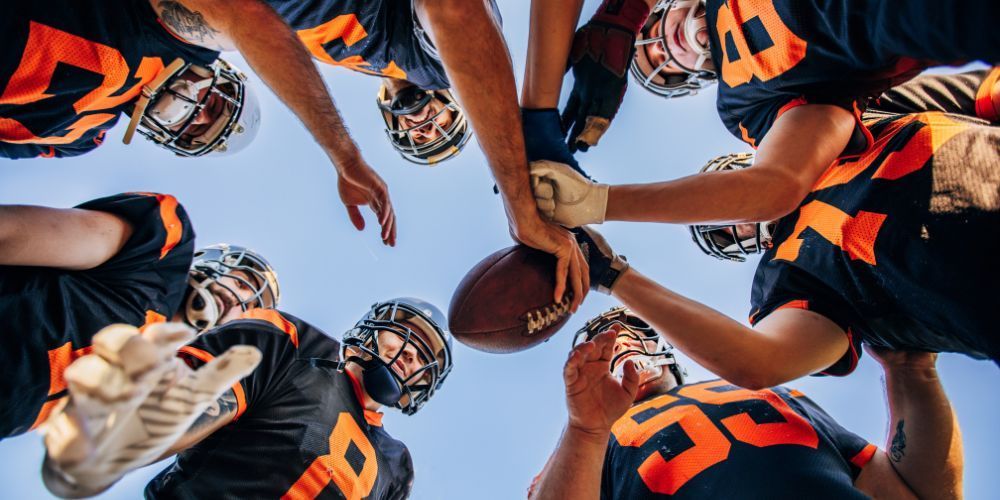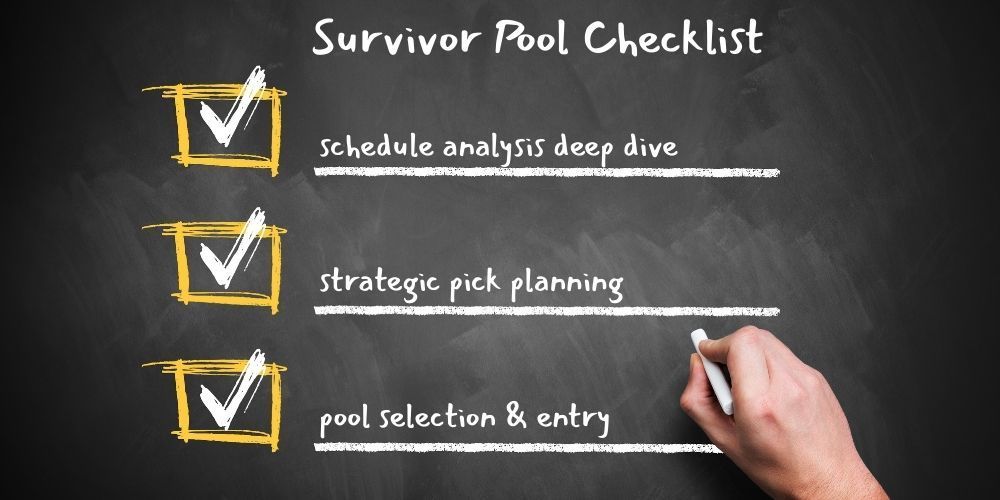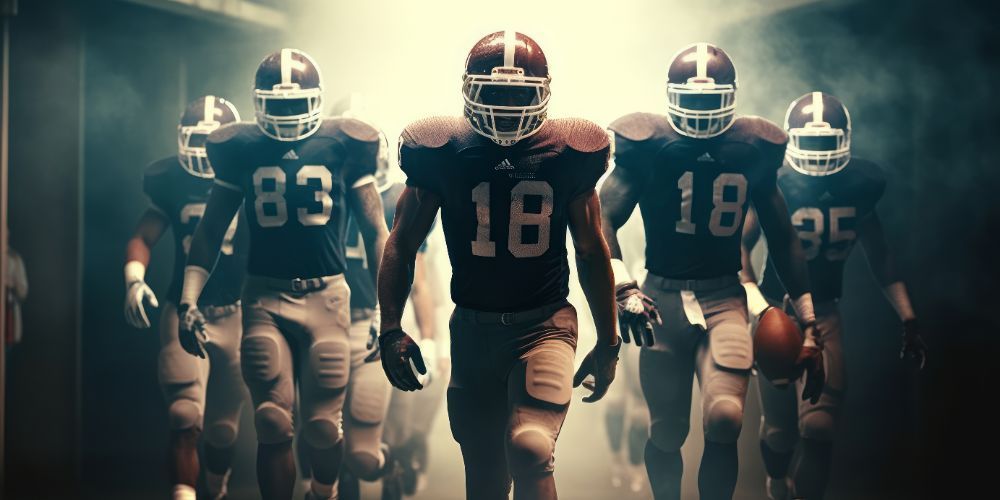Survivor Pool Injury Analysis: How Depth Charts Impact Your Picks
William Flaiz • August 13, 2025
In survivor pools, one loss eliminates you from contention. While most players focus on obvious factors like team records and point spreads, the smartest survivors dig deeper into injury reports and depth charts. A star quarterback's hamstring injury or a decimated offensive line can turn a "safe" pick into a pool-ending disaster.
Understanding how to analyze injuries and depth charts gives you a crucial edge over casual players who rely solely on team names and Vegas favorites.

Why Injuries Matter More in Survivor Pools
Traditional NFL betting spreads injuries into the point spread, but survivor pools operate differently. You're not trying to cover a spread—you need one thing: a win. This fundamental difference makes injury analysis even more critical.
Consider these scenarios that have derailed countless survivor pool runs:
- The Star Quarterback Trap: You pick the Chiefs as a 10-point favorite, but Patrick Mahomes is questionable with an ankle injury. Even if he plays, a hobbled Mahomes changes the entire game dynamic.
- The Depth Chart Disaster: You select the 49ers laying 7 points, but their top three running backs are injured. Suddenly, their offensive game plan becomes one-dimensional and predictable.
- The Hidden Weakness: You take the Ravens giving 6 points, but their starting center and both guards are out. The opponent's pass rush turns Lamar Jackson into a scrambling mess.
Reading Depth Charts Like a Pro
NFL depth charts aren't just roster listings—they're roadmaps to team vulnerability and strength. Here's how to analyze them effectively:
Position Value Hierarchy
Not all injuries carry equal weight. Prioritize your analysis based on positional impact:
Tier 1: Game-Changers
- Quarterback (obvious but worth stating)
- Elite pass rushers and coverage players
- Offensive line anchors (left tackle, center)
Tier 2: Significant Impact
- Top wide receivers and running backs
- Starting defensive backs in passing attacks
- Kickers in close games
Tier 3: Situational Concerns
- Depth at skill positions
- Special teams coverage specialists
- Backup linemen in specific matchups
Evaluating Backup Quality
The difference between a quality backup and a replacement-level player can swing games by multiple touchdowns. Research these factors:
- Experience Level: Has the backup started NFL games recently? Preseason snaps don't translate to regular season pressure.
- Scheme Fit: Some backups excel in specific systems but struggle when asked to replicate a starter's skill set.
- Coaching Confidence: Pay attention to press conferences and beat reporter insights about coaching staff comfort with backup options.
The Injury Report Timeline
NFL injury reports follow a predictable pattern that smart survivor pool players can exploit:
Wednesday: The Foundation
Teams release their first injury report, establishing the baseline. Key players listed here are genuinely concerned, not gamesmanship.
Thursday: The Refinement
Status changes on Thursday often indicate the actual severity. Players who improve from "limited" to "full" are likely playing. Those who remain "limited" or regress are genuine concerns.
Friday: The Reality Check
Friday's report is closest to game-day reality. Players listed as "questionable" have roughly 50-50 odds of playing effectively, regardless of whether they suit up.
Sunday Morning: The Final Call
Pregame warm-ups reveal the truth. A quarterback testing mobility during warm-ups tells you everything about their availability and effectiveness.
Advanced Depth Chart Analysis
The Ripple Effect
One injury rarely impacts just one position. A starting center's injury might force the guard to slide over, weakening two positions instead of one.
Map these cascading effects:
Example: Bills lose their starting right tackle. The backup right tackle moves over, forcing a practice squad player into the lineup. Now you have two compromised positions on the line.
Matchup-Specific Concerns
Some backup players excel in certain matchups while struggling in others:
Example: A backup safety might handle slot receivers adequately but struggle against athletic tight ends. Check the opponent's preferred targets and formations.
Recent Performance Trends
Injured players returning from multi-week absences often need time to regain game speed and timing, especially skill position players and quarterbacks.
Practical Application Strategies
The Injury Opportunity Matrix
Create a simple framework for evaluating teams each week:
- Green Light: Healthy roster, quality depth at key positions, favorable matchup
- Yellow Light: Minor injuries to non-essential players, adequate backup options
- Red Light: Key player injuries, poor depth, or multiple injuries at same position group
Stack Ranking Your Options
When multiple teams seem viable, injury analysis becomes the tiebreaker:
- Roster Health: Full strength beats compromised, even with tougher opponents
- Depth Quality: Teams with proven backups over those hoping for miracles
- Injury Trajectory: Players getting healthier vs. those getting worse
The Contrarian Play
Sometimes injuries create opportunity. When public perception overreacts to a star player's absence, the line might overcorrect, creating value on a team with quality depth.
Example: Aaron Rodgers sits with a minor injury, but the Steelers' backup has performed well in limited action. The public avoids Pittsburgh, but the matchup remains favorable.

Red Flags to Avoid
The "Probable" Trap
Players listed as "probable" or even unlisted can still be compromised. Quarterbacks playing through shoulder injuries, running backs with ankle issues, and linemen with hand problems all perform below their standard level.
The Multiple Injury Cascade
Teams dealing with injuries at multiple positions within the same unit (like three offensive linemen or two starting cornerbacks) face exponentially higher risk of breakdowns.
The Short Week Concern
Thursday Night Football compounds injury concerns. Players have less recovery time, and teams have less practice time to adjust their schemes around injured players.
Using Technology and Resources
Injury Tracking Tools
- NFL.com Injury Reports: Official but sometimes vague
- Beat Reporter Twitter: Often more accurate than official reports
- Fantasy Football Platforms: Aggregate multiple sources for clearer pictures
Depth Chart Resources
- Ourlads Guide: Most comprehensive depth chart analysis
- Team Websites: Official but sometimes outdated
- Local Beat Writers: Best source for actual playing time expectations
Game Week Decision Framework
Tuesday-Wednesday: Initial Assessment
Review injury reports and depth charts for all potential picks. Eliminate teams with significant concerns at critical positions.
Thursday-Friday: Refinement
Monitor practice reports and beat writer insights. Narrow your list to 2-3 viable options based on injury developments.
Saturday-Sunday: Final Decision
Make your pick based on the most current information, but have backup options ready if breaking news changes the landscape.
Common Mistakes to Avoid
Overreacting to Star Names
A team missing its star player isn't automatically a bad pick if they have quality depth and a favorable matchup. Evaluate the actual impact, not just the name recognition.
Ignoring Cumulative Effects
Three "minor" injuries can be worse than one major injury. A slightly compromised offensive line, a dinged-up quarterback, and a limited top receiver might spell disaster together.
Relying on Outdated Information
Injury situations change rapidly. Information from Monday might be irrelevant by Friday. Always use the most current data available.
Building Your Injury Analysis Routine
Weekly Preparation
- Monday: Review all games for obvious injury concerns from the previous week
- Tuesday: Initial depth chart analysis for potential picks
- Wednesday: First injury report review and elimination of high-risk options
- Thursday: Refinement based on practice participation
- Friday: Final injury report analysis and backup plan preparation
- Sunday: Last-minute adjustments based on pregame reports
Season-Long Tracking
Maintain a spreadsheet tracking:
- Key players' injury histories
- Backup performance when called upon
- Teams' injury management philosophies
- Coaching staff comfort levels with backup options
Successful survivor pool players treat injury analysis as seriously as studying point spreads and team records. The extra research time invested in understanding depth charts and injury reports pays dividends when you avoid a pool-ending upset or identify a contrarian opportunity others miss.
Remember: in survivor pools, you're not trying to be right about everything—you're trying to avoid being catastrophically wrong about anything. Thorough injury and depth chart analysis is your insurance policy against preventable disasters.
How much should I weigh injury concerns versus other factors like point spreads and team records?
Injury analysis should serve as a filter rather than the primary decision factor. Start with fundamentally sound picks (good teams in favorable spots), then use injury analysis to eliminate options with significant risk or identify overlooked opportunities. A star player's absence doesn't automatically make a team unpickable, but it should prompt deeper investigation into the backup situation and adjust your confidence level accordingly.
What's the difference between a player being "limited" in practice versus "full" participation, and how does this impact game-day performance?
"Limited" participation typically indicates a player is managing an injury but expects to play, though potentially with reduced effectiveness or snap count. "Full" participation suggests the player has recovered adequately for normal usage. However, the transition from "limited" to "full" matters more than the static designation. A quarterback who progresses from "limited" to "full" throughout the week is usually fine, while one who remains "limited" or regresses may struggle with timing and mobility even if they play.
Should I avoid teams with backup quarterbacks, or are there situations where backup QBs can still provide survivor pool value?
Backup quarterbacks aren't automatic disqualifiers, but they require careful evaluation. Consider the backup's experience level, the team's supporting cast strength, and the matchup difficulty. A veteran backup with a strong running game and defense facing a weak opponent can still provide value, especially if the public overreacts and creates a contrarian opportunity. However, rookie or inexperienced backups in challenging road environments are typically best avoided regardless of point spreads.












